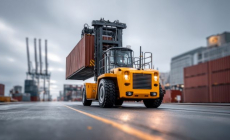-
AI startup Onton raises $7.5M to reinvent the way the world discovers and decides what to buy - November 26, 2025
-
Forklift Market Positions for Recovery as Confidence Expected to Build from 2026 - November 26, 2025
-
PROCare achieves 300% order capacity increase and 99% picking accuracy with Forterro’s ERP solution, Orderwise - November 26, 2025
-
DHL boosts operational efficiency and customer communications with HappyRobot’s AI Agents - November 25, 2025
-
STENA LINE TEAMS UP WITH CAMERA TELEMATICS TO DRIVE SAFETY IMPROVEMENTS AT IRISH SEA PORTS - November 25, 2025
-
Another design award for Toyota’s lithium-ion Traigo_i counterbalanced forklift - November 21, 2025
-
Stuut Technologies Raises $29.5 Million Series A Led by Andreessen Horowitz to Automate Accounts Receivable Work - November 20, 2025
-
INCREASED DIGITAL INVESTMENT REQUIRED TO KEEP PACE WITH 2026 CUSTOMS CHANGES - November 19, 2025
-
FULFILMENT SOLUTIONS FOR SPORTS MERCHANDISE: KEEPING OUR EYE ON THE GAME - November 19, 2025
-
COMPLEX, COSTLY & CONFUSING – THE END OF DE MINIMIS - November 19, 2025
The continuing growth of online shopping drives demand for new adaptable warehousing
Over the past decade online shopping has escalated at a phenomenal rate in the UK resulting in a demand for warehouse space which has nearly doubled.
Between 2007 and March 2018, around 235 million sq ft of warehouse space was leased or purchased across the United Kingdom which is equivalent to more than 3,000 Wembley Stadiums. According to CBRE about 60% of this warehousing space is used by retailers, feeding the demand of online shopping.
According to John Munnelly, Head of Operations at John Lewis: “Logistics is becoming the new retail”. 65% of activity in logistics is retail driven. A greater shift towards online business means a greater demand and competition for cost effective 3PL storage space so companies can adapt to eCommerce demands and the demands of their customers.
Amazon took a quarter of available UK logistics space in 2016 and the key takeaway from this is that businesses are going to need a lot more warehouse space for storing more product in the UK. They are also looking for the ability to be able to make structural alterations to accommodate future demands.
Flexibility, agility, capability and dependability are the key factors when looking forward at warehousing. How can warehousing cope with the demand and growth of online shopping? One answer is modular designed semi-permanent structures. Rubb Buildings a is UK manufacturer of these type of structures, and the company has seen an increase in the demand for adaptable warehousing.
Rubb Buildings Ltd Managing Director Ian Hindmoor commented “Feedback from our customers suggests that they are planning for the future, to be able to maintain the flow of their production and fulfil the demand from their customers. Rubb storage facilities provide an alternative and sustainable solution to traditional storage warehouses. To keep up with this ever-changing environment a semi-permanent fabric structure helps save on costs and is able to adapt to the changing requirements of the end user.”
Flexible warehouse space provides businesses with many unique advantages. The benefits of semi-permanent structures include fast design, manufacture and construction, with the flexibility to be adapted, modified, extended or relocated if needed. This allows clients to adapt quickly to change.

































